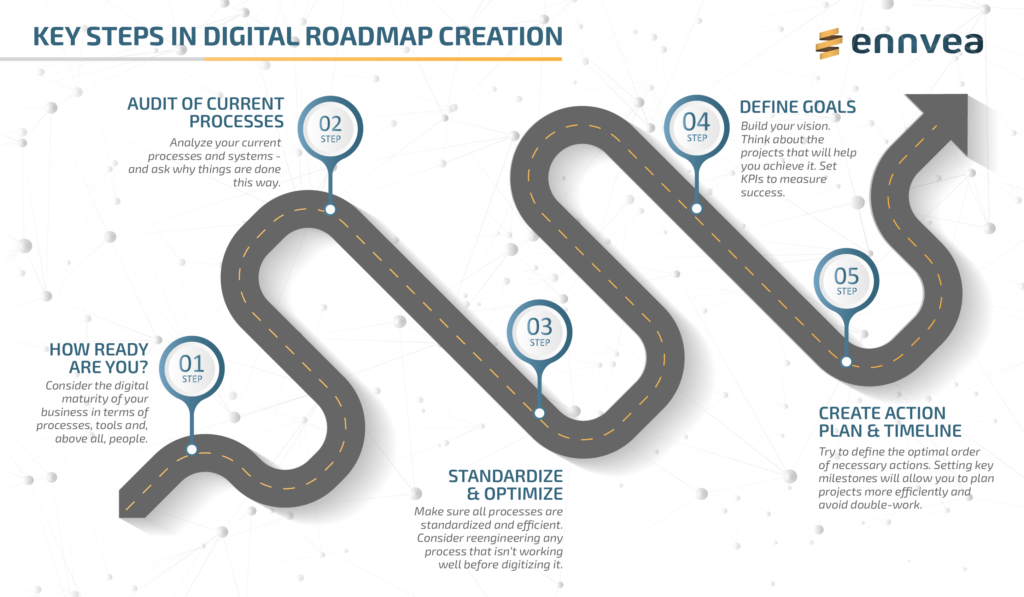Can you imagine a Dakar rally driver that only cares about completing a single stage – and not the entire race? Probably not. Yet that’s exactly what manufacturing companies are doing if they implement a digitisation project without considering if the project is in line with their digitisation strategy. Or without even having one. Let’s look into the WHYs and HOWs of digitisation roadmaps.
A CLIENT’S STORY
Recently, we were approached by a client who was planning a WMS project and requested our assistance. After a few initial discussions with the core project team, we came to the conclusion (much to the client’s surprise) that although we had the know-how and capacities to help, we did not recommend implementing that particular project at that time.
Why? During our discussions, one of the most important questions that we asked the project team was:
Based on our experience, we recommend taking these points into consideration when creating your digital transformation strategy.
1. HOW “READY” ARE YOU?
This question deserves a much more extensive answer than just a short paragraph (and we will address it more thoroughly in one of our future posts). A lot has been written about digital maturity – the preparedness of a business for digital transformation. It is a complex concept that requires a detailed understanding of current processes as well as all resources – tools (digital and non-digital) and, most importantly, people. It is people, their willingness and readiness to learn new things, that sets a project up for success – or failure.
2. ANALYZE THE CURRENT STATUS
Even without carrying out a proper digital maturity analysis, we always recommend looking at the current processes and systems. What we are interested in is not only the processes themselves but also the reasons why things are done in that particular way. Oftentimes, the reason is that “it’s always been done like that,” which does not necessarily mean that it is the best possible way (see point 3).
Secondly, we take a look at the systems in place – and by that we don’t mean just advanced software tools but also Excel sheets and paper-based flows that are used across the company. Last but not least, it is also important to compare the day-to-day reality with the ideas of the management. Sometimes there are discrepancies that need to be addressed before proceeding further.
3. STANDARDIZE & OPTIMIZE
One of the biggest mistakes that can be made in digitisation projects is digitising processes which are not optimal. Yes, process reengineering requires extra work – but it is definitely worth the effort. The problems you are struggling with right now will not magically disappear once you replace paper or Excel sheets with a more advanced system. It will still be the same process.
Making sure that there is a good level of process standardisation is important, too. What happens quite often is that a certain piece of know-how is only in the head of a long-time employee (and they might even be the only one who knows the process from A to Z). This needs to be taken care of and such a process needs to be well documented and standardized before moving on.
Otherwise you might find yourself at the project kick-off – when you realize that you need much more time for the preparation of essential data. This increases the demands for local resources (somebody has to do all the work) and leads to unnecessary pressure, delays and other complications (including dissatisfied management).
4. DEFINE GOALS
This is where you ask yourselves the big question:
- First, describe your vision – the ideal state. How far along do you want to get on your digitisation journey?
- Think about the projects you want to implement in order to get there. What are their main goals (OEE increase, efficiency improvement…)?
- Define the KPIs that will help you measure your success.
- Consider the future digital ecosystem as a whole. Think about the necessary system integrations.
- Define the data flow. Which system is going to serve as the primary source of truth? (The last thing you want to end up with is data duplicity and any kind of double-work.)
- Don’t forget about people. They are the most important part of digital transformation. They are going to use the software tools on a daily basis. Ideally they will love using the new tools and systems rather than hating their guts for having to work with them. The user experience should be a given but the reality is that it’s commonly overlooked. That’s why they need to get a good command of the systems and to feel that they are doing their job. This is the only way you will be able to achieve your goals.
5. CREATE AN ACTION PLAN (AND A TIMELINE)
Now it’s time to think about all the actions that need to be taken in order to achieve the objectives. Make a list of projects that you want to implement. Analyze the current situation (e.g. how prepared your data is). Assess the risks.
Although it might not be possible to create a precise timeline, we strongly recommend setting milestones that will help you plan and implement projects more efficiently – at least in terms of priorities and prerequisites. For example, if you are unhappy with your current ERP, you might want to start there as this system usually serves as the “backbone” of the business – and continue with more advanced (or more specialized) tools. Or maybe you know that you will have to change some processes before implementing any particular projects. Or improve your IT infrastructure.







